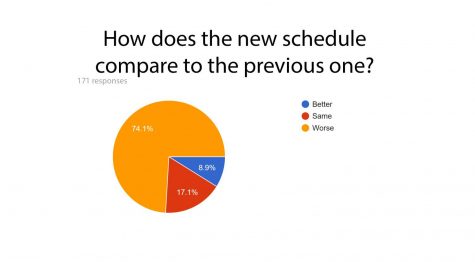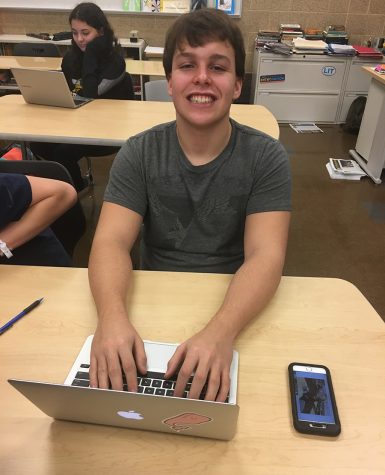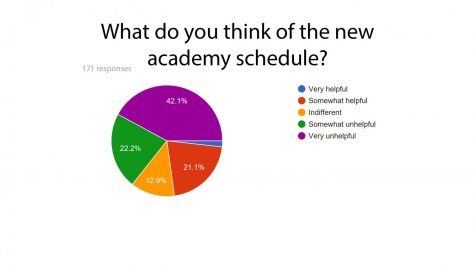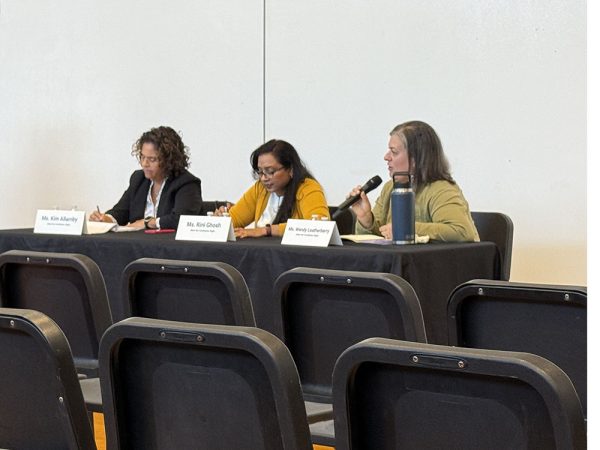Students and Staff Respond to New Schedule
Alex Shupp via Bcomber.org Archives
This year, Beachwood High School students can sleep 35 minutes later.
Administrators introduced a new bell schedule this school year. The most notable differences are the 7:35 a.m. start time, 2:55 p.m. end time, midday academy periods and Thursday morning study hall.
Principal Tony Srithai implemented the schedule with the goals of embedding academy within the day, offering extended academy on Wednesdays and giving teachers common planning time—all while allowing these changes to support closed campus.
“[Thinking] back to last year [with the] assemblies we had to host during the school day, it meant we would [have to throw] some random schedule at the kids,” he said. “It was hard to pull that off without being disruptive to the school day.”
“One of my personal goals this year is to minimize the amount of lost instructional time,” he added.
Assemblies can now be scheduled on Thursday mornings before school or during mid-day academy time.
“We had two assemblies in the beginning of the school year that weren’t disruptive to the school day,” he said.

Are More Students Attending Academy?
It is difficult to measure the success of the new schedule so early in the year.
Spanish teacher Daria Cayne said in mid-September that the number of kids in her academies has decreased, but she acknowledges that it’s too early to tell.
“I think it’s the beginning of the year and kids are [still learning] the importance of coming to academy,” she said.
On the other hand, history teacher John Perse has seen an increase in the number of students in academy, so much so that it could be difficult to manage.
“I tend to get—maybe once a week—ten to twelve kids at once,” he said. “If all of those students had questions for me, there’s no way that, in 25 minutes, I could effectively deal with each student on an individual basis.”
But Perse mentioned that most kids aren’t asking questions.
“They have used the academy like a study hall,” he said. “The students are coming to sit and get some work done.”
Most teachers are keeping academy attendance this year, and the number of academy visits range from 30 to 160 per teacher as of the end of September, but there is no data from last year to compare it with.
There has been some pushback on scheduling assemblies during academy time.
During Suicide Prevention Week, assemblies were held during academy, and some students expressed frustration about not getting enough academy time.
Junior Parker Gill voiced his concern about inconsistent academies.
“The way [the new schedule] is implemented is if you are going to have an assembly, it needs to be in the middle of the day during academy or before or after school,” he said.
Cayne also mentioned this disadvantage.
“[One] of the pitfalls I see of this kind of schedule [is that] my students don’t have academy on Thursdays,” she said. “[And] when we have assemblies, they lose their academy [period].”
In response to these concerns, administrators scheduled the Sept. 28 and Oct. 5 mental agility mini-lessons without interfering with academy. However, this required a modified schedule.
Attitudes Towards New Schedule
Student response to the schedule has been mostly negative.
In a recent Beachcomber survey of 171 BHS students, 59% indicated that they believe that the new schedule is not beneficial.
Of students who experienced the previous schedule, 74% indicated that they believe the new schedule is worse.
However, some students prefer the new schedule.
“I’ve had plenty of meetings with students who have issues with different components of the schedule, but I’ve had plenty of students tell me they like the new schedule,” Srithai said.
“I like it because it gives me more time to eat lunch between periods,” sophomore Corey Reidenbach said.
Freshman Amelie Cotta sees the midday academy as a positive aspect of the new schedule.
“I enjoy the opportunity of academy because I go to sleep around 1-2 [a.m.] trying to tackle the mountain of work I’m assigned,” Cotta said. “With [midday] academy, I can choose to complete any leftover homework, sleep, or get extra help.”
“It’s a nice break during the day,” she added.
“Students need to realize that I did not build the master schedule with [one student] in mind,” Srithai said. “I build the master schedule with 550 kids in mind, and doing what is best for the entire student body.”
Cayne made it clear that she is impartial to the new schedule.
“[Like anything that’s new,] I think it’s just taking some getting used to,” she said. “I try to stay open-minded and make it work the best it can.”
How Was the Decision Made?
Srithai says he created the schedule through teacher feedback.
“It [wasn’t] something implemented without the feedback of teachers and staff,” Srithai said. “We met with a teacher committee, [which met on] a volunteer basis; teachers came to share their ideas on things they would like to see in a new schedule.”
According to Srithai, several drafts of the new schedule were shared with the staff for their feedback.
“It was an ongoing process of meeting with teachers [and] taking it back to the whole team, using feedback and establishing the [new] schedule,” he explained.
However, Cayne did not feel that the staff had a significant role.
“We gave some input, but I really didn’t have a substantial role,” she said. “[The schedule] was already set in motion.”
Perse agreed.
“It was put out to us if we [teachers] wanted to get involved,” he said. “But I [didn’t] work with anyone in terms of the schedule.”
Student input was almost nonexistent.
While Srithai held a student open forum last year about the schedule change, it was already set in motion.
The Value of 15 Minutes
Srithai doesn’t think school starting 15 minutes earlier is a huge issue.
“Our middle school starts fairly early,” he said. “If I’m a freshman and just experienced the middle school schedule, it should be old hat.”
However, Beachcomber survey data shows that 74.9% of respondents want to return to the old start time. In the survey’s written comments, 12 students mentioned their lack of sleep due to the new schedule.
A 2014 study by the American Academy of Pediatrics links earlier school start times to insufficient sleep in adolescents.
According to the Nationwide Children’s Hospitals, most teenagers need around 9 ¼ hours of sleep. Without proper sleep, teenagers experience problems with attention, memory, decision making, reaction time and creativity—all leading to poor grades.
Some may suggest that teens should just go to bed earlier.
But in a recent op-ed published in the New York Times, Henry Nicholls explains that would not solve the problem.
[Adolescents] become rewired as night owls [after puberty], staying awake later and then sleeping in,” Nicholls wrote. “[It’s] driven by changes in the way the brain responds to light.”
“Prying a teenager out of bed at 6 a.m. to get to school is the equivalent of waking an adult at 4 a.m.,” he added. “The brain will be at its least active in the 24-hour cycle.”
One student survey respondent mentioned lack of sleep due to the new schedule.
“The old schedule was so much better because the start was later, and the end was earlier, which [meant] we [could] get more sleep, especially for people, such as me, who have extracurriculars which go far into the night.”
Perse explained how the earlier start time affects his own routine.
“I [used to] have at least an hour. Now I have 40-45 minutes before class starts.”
Perse emphasized the importance of the time he has in the morning.
“Morning is the only time of day when I can sit and catch my breath,” he said. “[It’s] a way to get myself together and organized before the day starts because once [it] starts, it’s crazy.”
But the schedule still preserves late start on Wednesdays and adds one on Thursdays.
“We’ll give you a second opportunity to sleep in on [Thursdays],” Srithai said. “It’s not to say students are just using that time for sleep, but if it’s getting caught up on homework or actually using and taking advantage of a study hall on Thursday, you’ve got that choice now.”
Srithai is not averse to trying to tweak the schedule again next year.
“I hope rolling out a new schedule in my second year sends the message that I’m not in the least opposed to change,” he said. “We’ll [similarly] see what changes we can take next school year.”

Tyler Pohlman has been writing for The Beachcomber since the fall of 2016. He has written several in-depth features and editorials about issues that affect...








![“My parents have always said that education is important. My parents are Chinese immigrants, I'm Chinese American, [and that's a] value that has always been ingrained in our community,” said Senior Lyndia Zheng, pictured with Tony Zheng](https://bcomber.org/wp-content/uploads/2025/10/DSC_4244-600x400.jpg)


